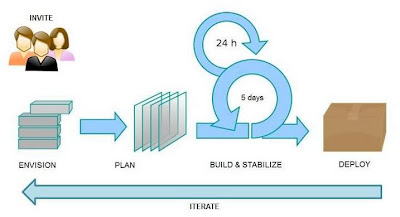 |
| Scrum Sprint |
Could a small group of subject matter experts, instructional designers, rich media experts and coders build a complete course in five days? This approach is gaining experience for
the writing of books, why not courses. The approach would fit very well with the
Agile Instructional Design approach and would take the best from the
unconference, the
book sprint and the
scrum sprint. This is how I would envision the
AID Sprint; I believe a sprint will occur within 5 to 10 working days.
- INVITE participants (be specific about subject domain)
Finding the right group is about composing the right invitation. Be sure to be as specific as you can about the subject of the AID sprint. But leave it loose enough to encourage participation. The real focus will come out of the envision step. All the participants need to agree to meet in the same space for the duration of the sprint.
- ENVISION the curriculum
Use brainstorming techniques, such as how stickies are used in an unconference. The point is to quickly create a shared vision of the module, course or curriculum - whichever fits best within the time available for the sprint.
- PLAN the modules
Plan the modules, create storyboards, identify different opportunities for rich media, determine assessment techniques. Being thorough here is important for this is where you will identify the tasks and the content items that need to be built. Out of this smaller focused and nimble groups (one to three people) may form to develop different content items (ie. short videos, assessment instruments, diagrams, text, etc...)
- BUILD the content
Start building the content. By this time the smaller focused groups would have formed to create individual items of content. It may be a good idea to have groups form around content types so they can focus and create all the identified pieces. The idea being, have one group focus on video resources, another on graphics, another on the text and organization, another on assessment. Once content starts to come together the sprint team should start to coalesce what they can. The iteration here will assist greatly in team energy and identifying what needs to be built and improved upon.
 |
| Agile Instructional Design Sprint |
- STABILIZE the technology
This is where everything has to come together and the user testing begins. The unified build brings together all the individual content pieces and the course flow comes together with the assessment approaches. The stabilization also includes the technology stabilization and the first round of deployment to the production environment.
- DEPLOY the course or module
Pushing work out to the web should occur as soon as a module is ready. Iteratively, pushing working modules out to your production internet environment creates success and attracts learners / testers / users. This is the only place you get real feedback, when you are live and on the internet. This feedback puts you on the road to continuous improvement.
- ITERATE
Go back to the envision and planning steps, iterate and build more modules. Learn from the build, stabilize and deploy steps just completed and add further learning modules. Work towards completion of complete curriculum.
Next Steps:
The next steps in proving the AID Sprint are twofold;
- To build a learning module focused on Agile Instructional Design with me occupying all roles. This will allow me to work out the bugs in the sprint methodology and to learn the technology for implementation.
- Send out an invite toward one of the curriculum areas I have identified in legal education for the adult public.

